Technology
India’s Tech Odyssey
Posted On:
15 JUN 2025 9:41AM
Introduction
Over the past eleven years, India has witnessed a profound transformation driven by technology. What was once seen as complex and inaccessible has now become a part of everyday life. Digital tools have brought government services closer to citizens, streamlined welfare delivery, and expanded financial inclusion, especially in rural and underserved regions. Under steady and visionary leadership, the focus has not just been on building systems, but on ensuring they reach and empower the last mile. From payments to public health, education to space exploration, technology has become the thread that ties governance with growth, making India a frontrunner in the digital age.
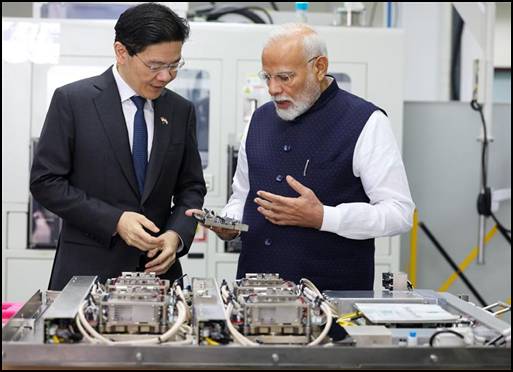
Digital Finance and Inclusion
Over the last eleven years, technology has brought financial services closer to people, especially in rural and remote areas. From making payments seamless to ensuring subsidies reach the right hands, digital tools have made public systems faster, cleaner, and more transparent.
UPI: A New Way to Pay
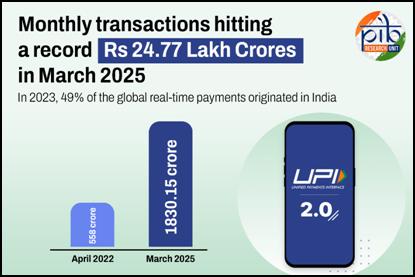 One of the most visible changes has been in the way Indians pay. The Unified Payments Interface (UPI) transformed digital transactions across the country. In March 2025, over 18,301 million transactions worth ₹24.77 lakh crore were carried out using UPI in just one month.The (UPI) system is now used by close to 460 million individuals and 65 million merchants. Digital payments are being made for even the smallest of transactions, with nearly 50 per cent classified as small or micropayments.According to the ACI Worldwide Report 2024, India accounted for 49% of global real-time transactions in 2023, reaffirming its position as a global leader in digital payments innovation.
One of the most visible changes has been in the way Indians pay. The Unified Payments Interface (UPI) transformed digital transactions across the country. In March 2025, over 18,301 million transactions worth ₹24.77 lakh crore were carried out using UPI in just one month.The (UPI) system is now used by close to 460 million individuals and 65 million merchants. Digital payments are being made for even the smallest of transactions, with nearly 50 per cent classified as small or micropayments.According to the ACI Worldwide Report 2024, India accounted for 49% of global real-time transactions in 2023, reaffirming its position as a global leader in digital payments innovation.
Aadhaar: Building Trust with Technology
The Aadhaar-based e-KYC system has helped simplify processes in both banking and public services. It made verification faster, reduced paperwork, and brought transparency across sectors. As of April 2025, 141.88 crore Aadhaar IDs have been generated. Aadhaar has now become a crucial part of India’s digital backbone, helping people access services with ease.
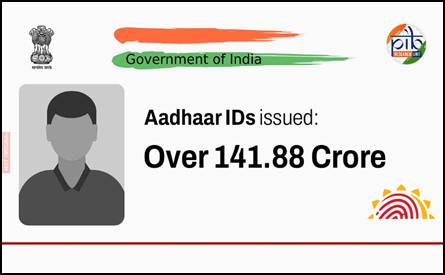
Direct Benefits Transfer: A Cleaner Welfare System
Direct Benefits Transfer (DBT), supported by Aadhaar authentication, changed the way subsidies and welfare payments are delivered. It helped remove fake beneficiaries and saved the government more than ₹3.48 lakh crore between 2015 and March 2023. As of May 2025, the total cumulative amount transferred through DBT has crossed ₹43.95 lakh crore. People now receive what is rightfully theirs, directly and on time.
The system has also helped clean up beneficiary databases. Over 5.87 crore ineligible ration card holders have been removed, and 4.23 crore duplicate or fake LPG connections have been cancelled, making the welfare system more targeted and transparent.
Connectivity and Infrastructure
Strong digital infrastructure is the foundation of any modern economy. Over the last eleven years, India has invested in expanding mobile networks and rural internet access. These efforts have not only improved connectivity but also created opportunities for growth, innovation, and inclusion.
5G and Connectivity
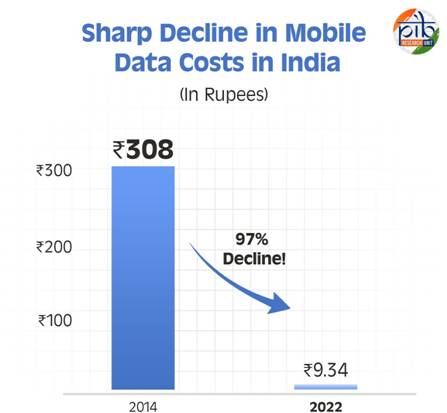 The real shift came with better mobile access. Since 2016, India has witnessed a rapid expansion of 4G coverage, bringing high-speed connectivity to vast corners of the country. The momentum continued with the arrival of 5G in October 2022, unlocking faster and smarter digital services. In just 22 months, India set up 4.74 lakh 5G Base Transceiver Stations (BTSs), achieving one of the fastest 5G rollouts globally. As of now, 5G services cover 99.6% of the country’s districts, with 2.95 lakh BTSs installed in 2023–24 alone. This leap in infrastructure supports a mobile subscriber base of 116 crore in 2025, highlighting the scale and reach of India’s digital surge.
The real shift came with better mobile access. Since 2016, India has witnessed a rapid expansion of 4G coverage, bringing high-speed connectivity to vast corners of the country. The momentum continued with the arrival of 5G in October 2022, unlocking faster and smarter digital services. In just 22 months, India set up 4.74 lakh 5G Base Transceiver Stations (BTSs), achieving one of the fastest 5G rollouts globally. As of now, 5G services cover 99.6% of the country’s districts, with 2.95 lakh BTSs installed in 2023–24 alone. This leap in infrastructure supports a mobile subscriber base of 116 crore in 2025, highlighting the scale and reach of India’s digital surge.
This improved mobile infrastructure has driven a massive surge in internet access. India’s internet user base has grown by 285% over the past 11 years. At the same time, the cost of wireless data has fallen steeply, from ₹308 per GB in 2014 to just ₹9.34 in 2022, making digital services far more affordable. More people than ever before are now able to participate in the digital economy.
BharatNet: Linking Villages to the Internet
A major part of this digital push has been about connecting rural India. The BharatNet project has brought high-speed internet to over 2.14 lakh Gram Panchayats. Nearly 6.93 lakh km of optical fibre cable has been laid under the initiative. Villages that once lacked basic internet access now have digital tools at their doorstep.
Public Service Delivery and Governance
Technology has reshaped the way people interact with the government. From health to documentation, public services have become faster, more transparent, and easier to access. Digital platforms have enabled smoother delivery of welfare and empowered citizens, especially in remote areas.
Co-WIN: Vaccines at Scale
The CoWIN (COVID Vaccine Intelligence Network) portal served as India’s digital backbone for managing its COVID-19 vaccination programme. It connected key stakeholders including vaccine manufacturers, administrators, healthcare workers, and beneficiaries across both public and private sectors.
Managing over 220 crore doses, CoWIN brought transparency, efficiency, and scale to one of the world’s largest vaccination drives. Its success has drawn international interest, with many countries exploring it as a model for their own digital public health systems.
Common Services Centres: Local Access to Services
The Common Services Centre (CSC) programme is a Government of India initiative that enables easy access to public services, especially for rural citizens. Operated by Village Level Entrepreneurs (VLEs), CSCs serve as digital access points that deliver a wide range of services including banking, insurance, education and telemedicine.
As of 31 January 2025, 5.97 lakh CSCs are operational across the country, with 4.73 lakh functioning at the Gram Panchayat level. More than just service outlets, CSCs stand as symbols of grassroots digital empowerment by bridging gaps, reducing travel and bringing governance to the doorstep.
Digital Capacity Building
India’s digital transformation is not just about access; it’s also about enabling people and institutions to use technology effectively. From breaking language barriers to upgrading the skills of civil servants, initiatives under Digital Capacity Building are ensuring that both citizens and government personnel are equipped to thrive in a digital-first environment.
Bhashini – Breaking Language Barriers
BHASHINI (BHASHa INterface for India) is a pioneering initiative under the National Language Translation Mission (NLTM), aimed at bridging India’s linguistic diversity through technology. By harnessing the power of artificial intelligence and natural language processing, BHASHINI enables access to digital content and public services in multiple Indian languages. Implemented by the Digital India BHASHINI Division under the Ministry of Electronics and Information Technology, the platform is helping realise the vision of a truly inclusive Digital India.
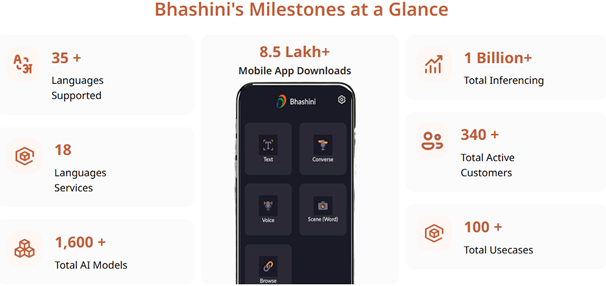
As of May 2025, BHASHINI supports 35+ languages with over 1,600 AI models and 18 language services. It is integrated into widely used platforms such as IRCTC, NPCI’s IVRS systems, and police documentation, making essential services more inclusive and accessible for all. With over 8.5 lakh mobile app downloads, BHASHINI continues to empower citizens to engage with digital platforms in the language of their choice.
Pradhan Mantri Gramin Digital Saksharta Abhiyan (PMGDISHA)
The Pradhan Mantri Gramin Digital Saksharta Abhiyan (PMGDISHA) was launched to empower rural citizens with basic digital literacy, targeting one person in every rural household across India. The initiative aimed to make at least 6 crore individuals digitally literate, enabling them to confidently access digital services and information.
Implemented by CSC eGovernance Services India Limited, the scheme leveraged a vast grassroots network of 4.39 lakh Common Service Centres spread across 2.52 lakh Gram Panchayats. As of the scheme’s formal conclusion on March 31, 2024, it had surpassed its original goal, successfully training 6.39 crore individuals, making it one of the largest digital literacy campaigns in the world.
Karmayogi Bharat + iGOT
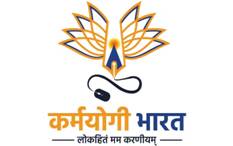 Karmayogi Bharat, under the Mission Karmayogi National Programme for Civil Services Capacity Building (NPCSCB), is reshaping the learning landscape for civil servants in India. Anchored in Indian ethos and national priorities, it provides a digital-first, competency-driven platform through the Integrated Government Online Training (iGOT) Karmayogi portal. The initiative aims to nurture a future ready civil service by equipping officials with the right Attitude, Skills, and Knowledge (ASK) to deliver efficient and citizen-centric governance.
Karmayogi Bharat, under the Mission Karmayogi National Programme for Civil Services Capacity Building (NPCSCB), is reshaping the learning landscape for civil servants in India. Anchored in Indian ethos and national priorities, it provides a digital-first, competency-driven platform through the Integrated Government Online Training (iGOT) Karmayogi portal. The initiative aims to nurture a future ready civil service by equipping officials with the right Attitude, Skills, and Knowledge (ASK) to deliver efficient and citizen-centric governance.
As of May 2025, over 1.07 crore Karmayogis have been onboarded onto the platform, which offers 2,588 courses spanning diverse governance domains. With more than 3.24 crore learning certificates issued, the platform facilitates continuous learning through online, face to face, and blended formats. It also supports peer learning via forums, career path guidance, and robust assessments, building a credible, agile, and capable public workforce aligned with the vision of a New India.
Advancing Strategic Tech Capabilities
India is rapidly strengthening its technological and industrial capabilities to foster self-reliance and innovation. Focused efforts are underway to build a robust artificial intelligence ecosystem, expand domestic semiconductor and display manufacturing, and boost indigenous defence production.
IndiaAI Mission
 The IndiaAI Mission, approved by the Union Cabinet under the leadership of the Hon’ble Prime Minister on 7 March 2024, is a landmark initiative to build a comprehensive and inclusive AI ecosystem in India. The mission is being implemented by the IndiaAI Independent Business Division (IBD), established under the Digital India Corporation by the Ministry of Electronics and Information Technology (MeitY). It focuses on seven strategic pillars: Compute Capacity, Innovation Centre, Datasets Platform, Application Development Initiative, FutureSkills, Startup Financing, and Safe & Trusted AI. With a total outlay of ₹10,371.92 crore over five years, the mission aims to advance responsible AI innovation aligned with national priorities.
The IndiaAI Mission, approved by the Union Cabinet under the leadership of the Hon’ble Prime Minister on 7 March 2024, is a landmark initiative to build a comprehensive and inclusive AI ecosystem in India. The mission is being implemented by the IndiaAI Independent Business Division (IBD), established under the Digital India Corporation by the Ministry of Electronics and Information Technology (MeitY). It focuses on seven strategic pillars: Compute Capacity, Innovation Centre, Datasets Platform, Application Development Initiative, FutureSkills, Startup Financing, and Safe & Trusted AI. With a total outlay of ₹10,371.92 crore over five years, the mission aims to advance responsible AI innovation aligned with national priorities.
As of 30 May 2025, India’s national compute capacity has crossed 34,000 GPUs, laying a strong foundation for AI-led research and development.
India Semiconductor Mission
The India Semiconductor Mission is a strategic initiative approved by the Government with a total outlay of ₹76,000 crore to build a robust semiconductor and display manufacturing ecosystem in the country. The programme provides 50 percent fiscal support on a pari passu basis for the setting up of Semiconductor Fabs, Display Fabs, Compound Semiconductors, Silicon Photonics, Sensors, and ATMP/OSAT facilities. It also offers a Product Design Linked Incentive of up to 50 percent of eligible expenditure and a Deployment Linked Incentive of 6 to 4 percent of net sales turnover over five years to promote chip design.
The mission aims to boost domestic value addition in electronics manufacturing, reduce reliance on imports, and integrate India’s electronics industry with global supply chains. As of May 14, 2025, six semiconductor manufacturing projects had been approved under the programme, with a cumulative investment of over ₹1.55 lakh crore. Already, five semiconductor units are in advanced stages of construction. The latest project, approved on May 14, 2025, is a joint venture between HCL and Foxconn to set up a display driver chip manufacturing plant near Jewar airport in Uttar Pradesh.
Defence Indigenisation
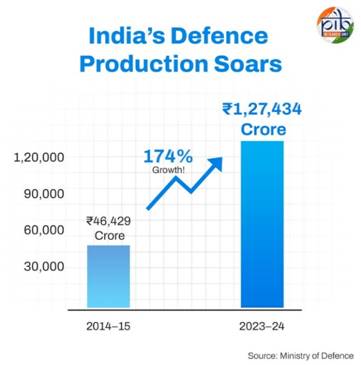 India recorded its highest ever defence production value in FY 2023–24, reaching ₹1,27,434 crore—a remarkable 174 percent increase from ₹46,429 crore in 2014–15. This surge reflects the growing strength of indigenous platforms such as the Light Combat Aircraft Tejas, Arjun tank, Akash missile system, ALH Dhruv helicopter, and multiple domestically built naval vessels.
India recorded its highest ever defence production value in FY 2023–24, reaching ₹1,27,434 crore—a remarkable 174 percent increase from ₹46,429 crore in 2014–15. This surge reflects the growing strength of indigenous platforms such as the Light Combat Aircraft Tejas, Arjun tank, Akash missile system, ALH Dhruv helicopter, and multiple domestically built naval vessels.
A key driver of this indigenisation push has been the introduction of five Positive Indigenisation Lists by the government. These lists restrict the import of over 5,500 defence items, promoting local manufacturing. As of February 2025, more than 3,000 of these items had already been indigenised. Covering a wide range from essential components to complex systems like radars, artillery, and light helicopters, these lists are laying the foundation for a self-sustaining and technologically advanced defence industrial base in India.
Leadership in Space: Sky is not the Limit
India’s space journey has evolved from modest beginnings to commanding global respect. Backed by strategic leadership and technological ambition, India is now a recognised space power with achievements that inspire the world.
Historic Milestones in Space Exploration
- On 15 February 2017, ISRO launched 104 satellites in a single mission — an unbroken world record.
- The Chandrayaan-3 mission marked a breakthrough, with India becoming the first country to land near the lunar south pole and the fourth nation to achieve a soft landing on the Moon.
- The Pragyan rover onboard confirmed the presence of sulphur on the Moon using the LIBS (Laser-Induced Breakdown Spectroscope) instrument.
- 23 August is now observed as National Space Day in honour of this achievement.
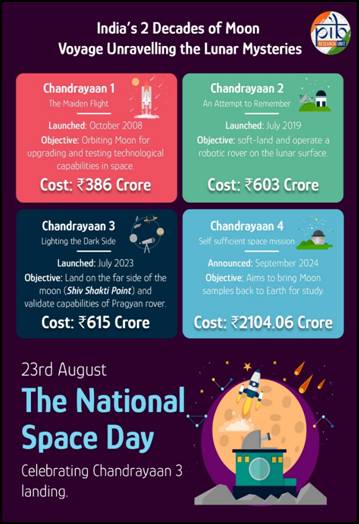
Growing Investments and Mission Success
- Over the last 11 years, ISRO has completed 100 space launch missions.
- India’s space budget has crossed ₹13,000 crore, showing increased commitment to space exploration.
- The Spadex (Space Debris Experimental) Mission is a new initiative to address the rising challenge of space debris in Earth’s orbit.
Expanding the Space Economy
India’s space sector is opening new frontiers:
- 328+ space startups have emerged in recent years.
- These startups are playing a crucial role in expanding India’s space innovation ecosystem, working alongside ISRO and other partners.
Bharatiya Antariksh Station
India’s long-term goals in space exploration include:
- Launching the Bharatiya Antariksh Station by 2035.
- Conducting the first human spaceflight mission in 2027.
- Planning a manned Moon mission by 2040.
Gaganyaan: India’s First Human Spaceflight Mission
The Gaganyaan Programme, India’s flagship human spaceflight mission, has been approved with a financial outlay of approximately ₹20,193 crore. This investment supports key technology development activities and a total of eight planned missions, including both uncrewed and crewed flights.
Four Indian Air Force test pilots have been selected and have completed their physical, psychological, and generic spaceflight training:
- Gp Capt. PB Nair
- Gp Capt. Ajit Krishnan
- Gp Capt. Angad Pratap
- Gp Capt. S Shukla
They are set to become India’s first astronauts in independent spaceflight, marking a new chapter in national scientific achievement.
Conclusion
India’s journey over the last eleven years shows what focused leadership and smart use of technology can achieve. From satellites in space to digital services in villages, the country has used innovation to bridge old gaps and unlock new opportunities. Governance has become faster, cleaner, and more accountable. Ordinary citizens now access services with ease, dignity, and trust. As India looks ahead, this strong digital foundation will continue to power its progress, placing people at the heart of its technological rise.
References:
Download in PDF
***
Explainer 14/ Series on 11 Years of Government
Santosh Kumar/ Sarla Meena/ Saurabh Kalia
(Explainer ID: 154657)
आगंतुक पटल : 5689
Provide suggestions / comments